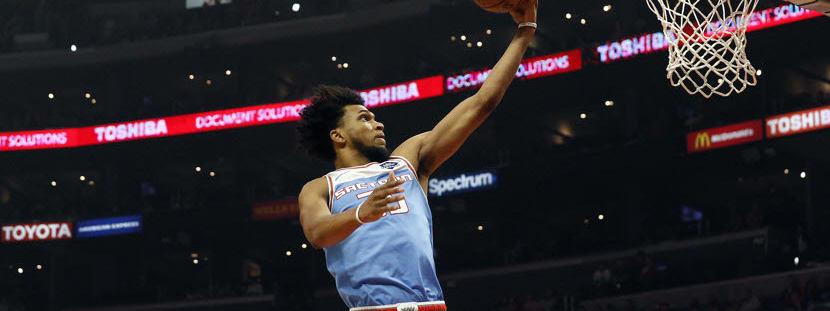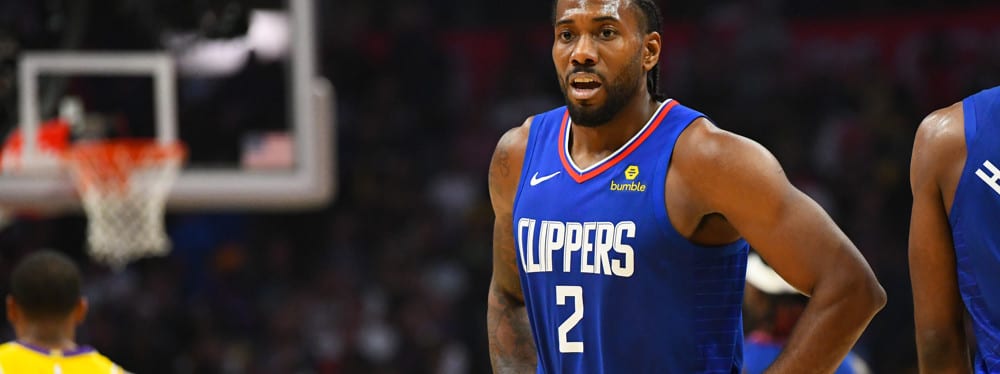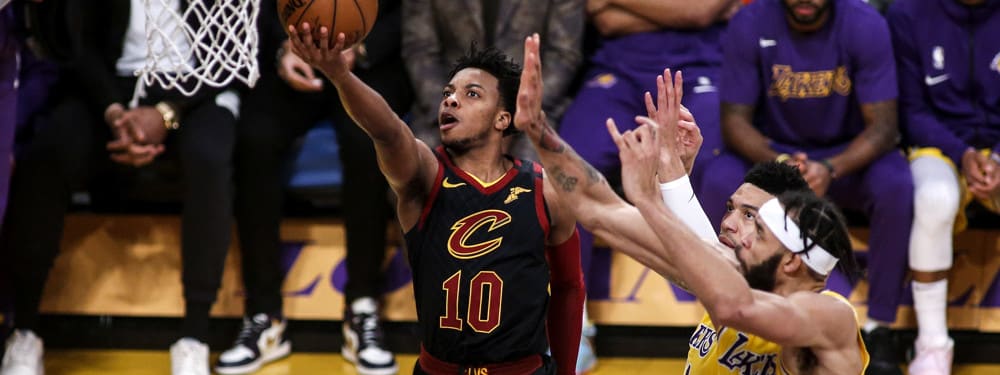Recent RotoWire Articles Featuring Brandon Knight
See More
After a long road back from a knee injury that included multiple trades and trips to the G League, Knight finally found some stability in Cleveland last season. The combo-guard appeared in 27 games for the Cavaliers, making 26 starts and averaging 8.5 points, 2.3 assists and 1.9 rebounds across 23 minutes per game. He also shot 37.1 percent behind the arc on 3.6 attempts per game. While Knight is still a long way away from the form he was in earlier in his career when he had his breakout season in Milwaukee, Knight is still just 27 years old and proved last season in limited time with the Cavaliers that he can be a contributor at the NBA level. The biggest question for Knight entering the 2019-20 season is how he fits into Cleveland's plan, as the team will likely want to see as much as they can out of their young backcourt of Collin Sexton, who had a great second half to his rookie season, and first-round pick Darius Garland. While Knight appears to be one of the first two guards off the bench for this Cavaliers team, he also is an interesting trade piece given he is in the final year of what was a five-year, $70 million contract. Should Knight prove his worth once again in Cleveland, and with the Cavaliers expected to struggle yet again this season, he could end up being a candidate to be dealt at some point next season to a team in need of backcourt depth, or he could provide a team with some salary-cap relief.
Knight's career has been marred by injury and that was no different during the 2017-18 campaign, as the 26-year-old missed the entire season after tearing the ACL in his left knee. He had also played less than 55 games in the prior two seasons as well, further exemplifying his inability to stay healthy. However, the expectation is that Knight is back to full strength after having over a year off to rehab his knee. There's also a pretty big hole to fill at point guard considering the Suns let Elfrid Payton walk in free agency and also opted to waive Tyler Ulis. That will give Knight every opportunity to claim a starting role, though his health will certainly dictate whether that comes to fruition. The Suns also drafted guard Elie Okobo early in the second round of this year's draft and he could ultimately get the call with the top unit if the Suns elect to prioritize his development rather than give a veteran like Knight the job. Either way, Knight will likely be on some sort of restrictions early on and will be nothing more than a late round flier in deeper leagues for those betting on his health. It is worth it to note that Knight is just three years past a 2015-16 campaign where he averaged 19.6 points, 5.1 assists, 3.9 rebounds and 1.2 steals across 36.0 minutes.
Knight suffered a torn ACL in his left knee over the summer, requiring surgery, and could miss the entirety of the upcoming 2017-18 season. The combo guard struggled to find his way into the Suns' rotation last season, playing in just 54 games and posting 11.0 points, 2.4 assists and 2.2 boards across 21.1 minutes per game while shooting 39.8 percent from the field -- all career-worsts. Now, it appears that there's a chance Knight won't participate at all during the 2017-18 season as the result of an ACL tear in his left knee, which he suffered while playing in his native South Florida. Though he wasn't expected to see a significant workload next season after floundering in a sixth-man role last year, his injury will likely open up more opportunities for the likes of Tyler Ulis and Elijah Millsap, assuming the Suns don't make a move to acquire another guard in free agency or via trade.
Knight combined with Eric Bledsoe to form one of the league’s more potent backcourts through the first two months of the season before injuries befell both of them. Bledsoe went down first with a season-ending torn meniscus in December, allowing Knight to take control of the offense before he succumbed to an adductor strain in late January and then a sports hernia shortly after returning to action in March. The injuries ended up limiting Knight to 52 games, but he still turned in career-best marks in most categories, averaging 19.6 points (on 41.5% shooting), 5.1 assists, 3.9 rebounds, 2.3 three-pointers and 1.2 steals in 36.0 minutes per game. Though Knight’s ability to finish near the rim and knock down shots from the outside made him an excellent sidekick to Bledsoe, his alarmingly high 3.4 turnovers per game often led to the easy transition points for the opposition. Knight will need to make strides in that area if the Suns are to be more competitive in 2016-17, but a decline in usage rate may be enough in itself to curb his turnovers. After Devin Booker submitted a promising rookie season, Knight could see his playing time scaled back a bit to create more opportunities for the shooting guard, which may equate to a slight drop in his production across the board. Even so, at just 24 years old and with a five-year, $70 million contract in tow, Knight will remain an integral part of the Suns’ immediate plans.
For the first half of last season, Knight was the catalyst for a surprise Bucks team that exceeded expectations and would go on to earn the sixth seed in the Eastern Conference. He averaged career-bests in field goal percentage, assists, and rebounds and was nearly an All-Star, just missing out on the final Eastern Conference reserve spot. Despite Knight's hot start, Milwaukee had reservations about making the 23-year-old its point guard of the future. At the trade deadline, the Bucks dealt Knight to Phoenix in a massive, three-team deal that brought reigning Rookie of the Year Michael Carter-Williams to Milwaukee. Knight, who signed a five-year, $70 million deal with the Suns this offseason, played in only 11 games after the trade, as a severe ankle sprain kept him sidelined for 15 of the team's final 16 contests. When he was on the court, he struggled, averaging just 13.4 points per game on 36 percent shooting, down from 17.8 points and 44 percent shooting in 52 games with the Bucks. Expected back at full health, and with a summer to acquaint himself with coach Jeff Hornacek's system, Knight projects to start alongside Eric Bledsoe in the backcourt. Neither player fits the mold of a "true" point guard, so it's likely they'll share primary ball-handling duties. While playing multiple point guards together ultimately failed for Hornacek last season, Knight, given his catch-and-shoot ability, figures to be a better fit off the ball than Goran Dragic or, especially, Isaiah Thomas. Archie Goodwin is expected to take a step forward, and rookie Devin Booker, after an encouraging summer, will be tough to keep off the floor, but Knight and Bledsoe are the clear top two in the Phoenix backcourt.
In his third NBA season, and first with the Bucks, Knight appeared in 72 games (starting 69) and set career highs in scoring (17.9), assists (4.9), rebounds (3.5), field goal percentage (42%), and free-throw percentage (80%). With a new coach to impress, Knight will look to prove last season's numbers weren't simply a result of him taking advantage of being the de facto go-to guy on a bad team. The biggest criticism of Knight at this point in his career is his inability to see the floor like a true point guard. While he was thrust into that role last season, the offseason additions of Jerryd Bayless and Kendall Marshall should allow Knight to play off the ball more frequently. He's a decent three-point shooter (36% career) but saw his percentage drop to a career-low 33 percent last season. One of the primary reasons for the decline was his high rate of pull-up attempts. Just 65 percent of Knight's made three-pointers resulted in an assist last season, compared to 89 percent with Detroit in 2012-13, when he shot nearly 37 percent from long range. Similar to last season, the Bucks' rotations are difficult to predict at this point. There's no doubt Knight will be one of Milwaukee's top contributors, but it remains to be seen if he'll spend more of his time at point guard or shooting guard.
In his first season with Milwaukee, Knight will start at point guard and could see minutes at the shooting guard spot as well. He struggled in the pick-and-roll setting in his two seasons with Detroit, averaging just 4.0 assists per game in 2012-13. Knight is a better three-point shooter and locker room presence than Brandon Jennings, but his decision-making will need to improve before he’s considered an upgrade at the position.
Knight put together a solid rookie campaign for the Pistons, earning All-Rookie First Team honors while finishing with averages of 12.8 points, 3.8 assists, 3.2 rebounds, 1.6 threes and 0.7 steals in 32 mpg. The 21-year-old point guard was an efficient scorer all season long, hitting 41.5 percent from the floor, 38.0 percent from downtown and 75.0 percent from the charity stripe. He also proved to be a decent rebounder for a 6-3 point guard, pulling down five or more boards 18 times. The one area where Knight needs to show growth is in his ball distribution. He will probably never be among the league leaders in dimes, but Knight’s assist totals should start climbing as he continues to develop. Any restraints the Pistons had on Knight last season should be gone from the equation this year as he’s clearly one of the team’s top building blocks alongside Monroe and Stuckey. After Kyrie Irving and Klay Thompson, Knight should be one of the top targets in fantasy from the 2011 NBA Draft class.
Knight was selected by the Pistons with the eighth overall pick of the 2011 NBA Draft. He’s known more for his scoring prowess than ability to create for his teammates, as evident by his 17.3 points per game during his lone college season at Kentucky. While not as highly touted as previous John Calipari point guards (Derrick Rose, Tyreke Evans, John Wall), Knight was still considered the second best point guard of his draft class. He may not start right off the bat, but Knight is expected to have a significant role for the Pistons during his rookie season.












